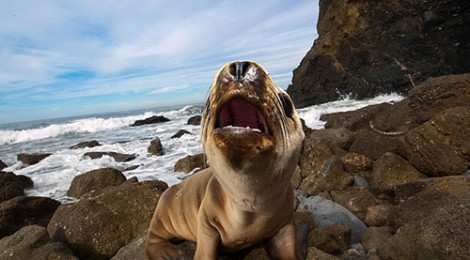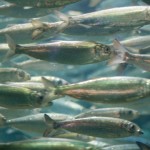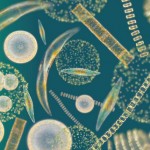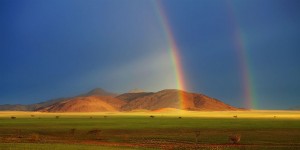
California Sea Lion Pups Starving Due To 2012’s Clearest Water On Earth
The starving pups weigh 25 lbs. not the 100 lbs. they should. This crisis of thousands sea lion pups starving to death on California beaches is being touted by ocean experts as a mystery. Sadly it is no mystery, but the reason and responsibility is something we all have to own up to. Perhaps our unwillingness to do so is the mystery.
I’ve been looking at the satellite data covering the offshore California ocean pastures for the past several years. The data reveals a dramatic collapse of these vital ocean pastures. Not up against to coast, but offshore in a critical ecosystem for this part of the world.
Satellite’s that track phytoplankton, the grass of those pastures, shows that last year instead of a rich abundance of plankton we saw instead the clearest water on earth. While some might think there is nothing more beautiful than a clear blue sea this is the stuff of ocean life’s worst horror, clear blue means lifeless.
Here’s a basic lesson in ocean pasture ecology.
Sea lions eat fish. All fish is plankton! This is just as true as Walt Whitman’s famous quote “All beef is grass.”
Mostly sea lions eat anchovies and herring off the coast of California, or they eat what eats those anchovies and herring. Those little fish eat plankton and with that plankton missing, that’s all she wrote for the sea lion pups.
When the anchovy and herring were trying to find something to eat last year on the way to becoming this years sea lion food they were swimming in that terrible clearest water on earth. And the vast majority of them simply starved to death. Those that survived were nearly starved to death and scrawny and hardly capable of feeding the Sea Lionesses and their pups. About those vital little fish, oh, no one was there to witness their demise.
The observation of cataclysmic collapse of the ocean pastures last year, the bottom of the food chain, is indisputable. And this years enormous numbers of starving sea lion pups on the beaches, and remember most of the starving pups don’t make it to the beach, is evidence of cataclysmic collapse at the top of the food chain. In ocean ecology we call the observation of starving sea lion pups in record numbers a perfect “proxy” for the health of their food fish. It ain’t lookin good for California sea lion food out there, the fish. This also means that everything else out there on our ocean pastures is in equally dire straits.
This dire collapse of the California ocean pastures is made far more ominous as last year was not an “nino” event. The waters were cold and full of nutrients and entirely normal so they should have bloomed. What the ocean pastures of California were missing last year were the mineral micronutrients, especially iron, that blows from Asia in the wind and empowers ocean phytoplankton to bloom.
The absence of the blooms is absolute evidence, via ecological proxy, of the absence of those vital mineral micronutrients. Naturally there is more satellite data to confirm this deadly series of events.
The result is clear, an unprecedented die off of California seal lions.
This was entirely forseeable and easily and inexpensively preventable! We just need and needed to be caring stewards of our ocean pastures.
So here is the good news.
Our village ocean pasture stewardship project last summer did something wonderful. It worked!
Working with a tiny native peoples village on an island in the North Pacific we brought the village ocean pasture back to life.
The work was/is the most extensive and intensive ocean pasture scientific undertaking in the history of ocean science, years of study and preparation, and mere months of effort replenishing mineral micronutrients to the ocean pasture. Through our efforts we replenished mineral micronutrients to the Haida ocean pasture in an amount equal to a single grain of salt, in our case natural iron rock dust, in each cubic meter of ocean.
A single fishing boat load of mineral micronutrients, just over 100 tonnes, and weeks of time to spread it ever so thinly, simply worked. The ocean pastures bloomed in an abundance equal to decades gone past when dust from Asia blew to our ocean pastures in abundance.
Today in the entire North Pacific the dust blowing from Asia has been dramatically reduced. This is due to multiple causes. One is that the farmers and soil conservationists of China and Mongolia have made tremendous progress in matching the work of the US Soil Conservation Service which is credited in ending the dust bowl days in the United States. Their introduction of western style winter wheat agriculture in the 1950’s transformed their dryland agriculture.
Their work has prevented millions of tonnes of valuable topsoil from blowing away in the wind. But this comes at a cost. Those millions of tonnes, hundreds of millions of tonnes of red dirt was feeding the ocean pastures of the North Pacific. We’ve watched the decline in plant life decline by more than 1% per year since we started watching with satellites in the early 1980’s.
The second and even greater impact on ocean pasture mineral dust decline is the CO2 for each and every one of us. Our world’s high and rising CO2 which is a nutrient for plants is incredibly effective with dryland plant life, such as the grasses that cover the lands of Western China and Mongolia, such places like the Gobi Desert.
With grasses, in dry lands, which Californian’s know very well, they are green and lush in the spring and dry and all but gone in the summer. That grass when it is green and lush, we call that good ground cover and it covers the ground and keeps the dirt from blowing in the wind.
When that grass runs out of water at the end of the spring it is because grass breathes just like you and I. They open cells on the leaf surface, called stomata, and breathe in air to exchange the Oxygen that they make for more CO2 that they require. They exchange these gases across membranes that must be wet to work, just like our lungs. But in the last hundred years, really the last 50 years, we have filled the air of the planet with 40% more CO2.
Dryland grasses are rejoicing, they have to breathe less to get the CO2 they need, that means they lose less water by evapo-transpiration and that water they save keeps them growing and greening and covering the soil for weeks longer each year. This we also see in our satellite and land based scientific data collections and it matches precisely with the decline of dust in the wind and dying ocean pastures.
So the good news comes from a tiny Indian village of fewer that 800 souls, with 705 unemployment, who have “bet the farm,” or really “bet on their ocean pasture.”
We have bet that we can give back to nature the dust we have taken from her. And in doing so bring back the fish.
And here’s there really wonderful news. IT WORKED!….read more here…
It can and must work in California’s ocean pastures too.
Links to other Starving Sea Lion pup stories
Since the beginning of the year, 1,293 emaciated sea lions found stranded on beaches from San Diego to Santa Barbara have been treated at seven facilities in the state, Sarah Wilkin of the National Oceanic and Atmospheric Administration said Wednesday during a conference call with reporters. The number is a record for strandings of live California sea lions along the Southern California coast from Jan. 1-April 30 since 1982, when formal record-keeping began. The low was 25 sea lions in 2000. The previous high was 659 in 1998, when the Pacific experienced a strong ocean-altering El Nino…
The National Oceanic and Atmospheric Administration (NOAA) declared an “unusual mortality event” last month in light of the spike in strandings. Since the beginning of the year, 1,293 sea lions have washed ashore from San Diego County to Santa Barbara County. That’s more than five times higher than the region’s historical average of 236…











